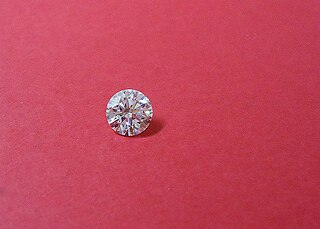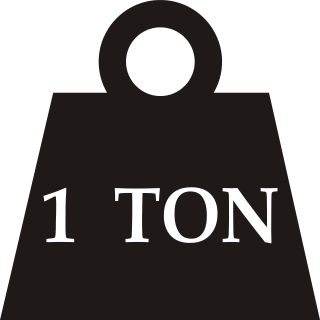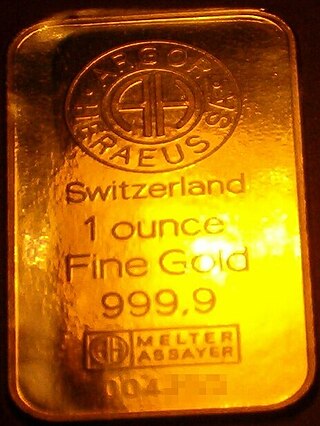Related Research Articles

The carat (ct) is a unit of mass equal to 200 mg, which is used for measuring gemstones and pearls. The current definition, sometimes known as the metric carat, was adopted in 1907 at the Fourth General Conference on Weights and Measures, and soon afterwards in many countries around the world. The carat is divisible into 100 points of 2 mg. Other subdivisions, and slightly different mass values, have been used in the past in different locations.
Density is a substance's mass per unit of volume. The symbol most often used for density is ρ, although the Latin letter D can also be used. Mathematically, density is defined as mass divided by volume:

The litre or liter is a metric unit of volume. It is equal to 1 cubic decimetre (dm3), 1000 cubic centimetres (cm3) or 0.001 cubic metres (m3). A cubic decimetre occupies a volume of 10 cm × 10 cm × 10 cm and is thus equal to one-thousandth of a cubic metre.

The pound or pound-mass is a unit of mass used in both the British imperial and United States customary systems of measurement. Various definitions have been used; the most common today is the international avoirdupois pound, which is legally defined as exactly 0.45359237 kilograms, and which is divided into 16 avoirdupois ounces. The international standard symbol for the avoirdupois pound is lb; an alternative symbol is lbm, #, and ℔ or ″̶.

Ton is any of several units of measure of mass, volume or force. It has a long history and has acquired several meanings and uses.

United States customary units form a system of measurement units commonly used in the United States and most U.S. territories, since being standardized and adopted in 1832. The United States customary system developed from English units that were in use in the British Empire before the U.S. became an independent country. The United Kingdom's system of measures was overhauled in 1824 to create the imperial system, which was officially adopted in 1826, changing the definitions of some of its units. Consequently, while many U.S. units are essentially similar to their imperial counterparts, there are noticeable differences between the systems.

The mole (symbol mol) is a unit of measurement, the base unit in the International System of Units (SI) for amount of substance, a quantity proportional to the number of elementary entities of a substance. One mole contains exactly 6.02214076×1023 elementary entities (approximately 602 sextillion or 602 billion times a trillion), which can be atoms, molecules, ions, or other particles. The number of particles in a mole is the Avogadro number (symbol N0) and the numerical value of the Avogadro constant (symbol NA) expressed in mol-1. The value was chosen based on the historical definition of the mole as the amount of substance that corresponds to the number of atoms in 12 grams of 12C, which made the mass of a mole of a compound expressed in grams numerically equal to the average molecular mass of the compound expressed in daltons. With the 2019 redefinition of the SI base units, the numerical equivalence is now only approximate but may be assumed for all practical purposes.

The kilogram per cubic metre is the unit of density in the International System of Units (SI). It is defined by dividing the SI unit of mass, the kilogram, by the SI unit of volume, the cubic metre.
Biblical and Talmudic units of measurement were used primarily by ancient Israelites and appear frequently within the Hebrew Bible as well as in later rabbinic writings, such as the Mishnah and Talmud. These units of measurement continue to be used in functions regulating Jewish contemporary life. The specificity of some of the units used and which are encompassed under these systems of measurement have given rise, in some instances, to disputes, owing to the discontinuation of their Hebrew names and their replacement by other names in modern usage.

The gram is a unit of mass in the International System of Units (SI) equal to one thousandth of a kilogram.

Troy weight is a system of units of mass that originated in 15th-century Kingdom of England and is primarily used in the precious metals industry. The troy weight units are the grain, the pennyweight, the troy ounce, and the troy pound. The troy grain is equal to the grain unit of the avoirdupois system, but the troy ounce is heavier than the avoirdupois ounce, and the troy pound is lighter than the avoirdupois pound. One troy ounce equals exactly 31.1034768 grams.
The ounce is any of several different units of mass, weight, or volume and is derived almost unchanged from the uncia, an Ancient Roman unit of measurement.

A pennyweight (dwt) is a unit of mass equal to 24 grains, 1⁄20 of a troy ounce, 1⁄240 of a troy pound, approximately 0.054857 avoirdupois ounce and exactly 1.55517384 grams. It is abbreviated dwt, d standing for denarius –, and later used as the symbol of an old British penny.

The tola also transliterated as tolah or tole, is a traditional Ancient Indian and South Asian unit of mass, now standardised as 180 grains or exactly ⅜ troy ounce. It was the base unit of mass in the British Indian system of weights and measures introduced in 1833, although it had been in use for much longer. It was also used in Aden and Zanzibar: in the latter, one tola was equivalent to 175.90 troy grains.
A system of units of measurement, also known as a system of units or system of measurement, is a collection of units of measurement and rules relating them to each other. Systems of measurement have historically been important, regulated and defined for the purposes of science and commerce. Instances in use include the International System of Units or SI, the British imperial system, and the United States customary system.

A gold bar, also known as gold bullion or a gold ingot, refers to a quantity of refined metallic gold that can be shaped in various forms, produced under standardized conditions of manufacture, labeling, and record-keeping. Larger varieties of gold bars, produced by casting molten metal into molds, are called ingots. Smaller bars are often created through minting or stamping from rolled gold sheets. Central banks typically hold the standard 400-troy-ounce Good Delivery gold bar in their gold reserves and it is widely traded among bullion dealers. Additionally, the kilobar, weighing 1,000 grams, and the 100-troy-ounce gold bar are popular for trading and investment due to their more manageable size and weight. These bars carry a minimal premium over the spot price of gold, facilitating small transfers between banks and traders. While most kilobars have a flat appearance, a preference for brick-shaped bars exists among some investors, particularly in Europe.

The Chinese Silver Panda is a series of silver bullion coins issued by the People's Republic of China. The design of the panda is changed every year and minted in different sizes and denominations, ranging from 0.5 troy oz. to 1 kilogram. Starting in 2016, Pandas switched to metric sizes. The 1 troy ounce coin was reduced to 30 grams, while the 5 troy ounce coin was reduced to 150 grams. There is also a Gold Panda series issued featuring the same designs as the Silver Panda coins.

Silver may be used as an investment like other precious metals. It has been regarded as a form of money and store of value for more than 4,000 years, although it lost its role as legal tender in developed countries when the use of the silver standard came to an end in 1935. Some countries mint bullion and collector coins, however, such as the American Silver Eagle with nominal face values. In 2009, the main demand for silver was for industrial applications (40%), jewellery, bullion coins, and exchange-traded products. In 2011, the global silver reserves amounted to 530,000 tonnes.
Before the introduction of the Metric system, one may divide the history of Indian systems of measurement into three main periods: the pre-Akbar's period, the period of the Akbar system, and the British colonial period.

The gram per cubic centimetre is a unit of density in the CGS system, and is commonly used in chemistry. It is defined by dividing the CGS unit of mass, the gram, by the CGS unit of volume, the cubic centimetre. The official SI symbols are g/cm3, g·cm−3, or g cm−3. It is equivalent to the units gram per millilitre (g/mL) and kilogram per litre (kg/L). The density of water is about 1 g/cm3, since the gram was originally defined as the mass of one cubic centimetre of water at its maximum density at 4 °C (39 °F).
References
- Gram Unit Converter A complete gram related information up to 18k .